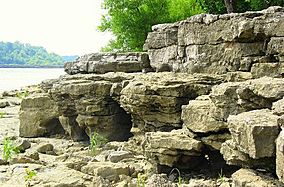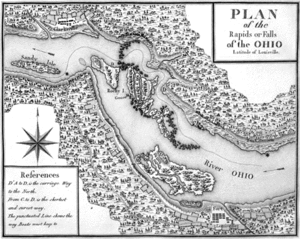Falls of the Ohio National Wildlife Conservation Area facts for kids
Quick facts for kids Falls of the Ohio National Wildlife Conservation Area |
|
|---|---|

Fossil formations at the shores of the Ohio River in Clarksville
|
|
| Location | Indiana, Kentucky |
| Nearest city | Louisville, Kentucky |
| Established | 1981 |
| Designated: | 1966 |
The Falls of the Ohio National Wildlife Conservation Area is a special area in two states, Indiana and Kentucky. It's located on the Ohio River near Louisville, Kentucky in the United States. The U.S. Army Corps of Engineers manages this important place.
It became a special federal area in 1981. Before that, in 1966, the falls were named a National Natural Landmark. This means it's a very important natural place that needs to be protected.
Contents
What are the Falls of the Ohio?
The Falls of the Ohio were once the only natural obstacle for boats on the Ohio River. These "falls" were actually fast-moving water, like rapids. They were created by the river slowly wearing away very old, hard limestone rocks. These rocks are about 386 million years old!
The cities of Louisville, Kentucky, and nearby Indiana towns like Jeffersonville, Clarksville, and New Albany, all grew because of these falls. Boats traveling on the river had to stop here. This was because the river dropped about 26 feet (8 meters) over two miles (3 km). People who knew the river well helped guide boats through this tricky part.
The falls weren't like a sudden, tall waterfall such as Niagara Falls. Instead, they were a long stretch of rapids. Still, they were a big, challenging obstacle for boats on this important waterway.
Changes to the Falls Over Time
To make it easier for boats to pass, the first locks on the Ohio River were built here. This was the Louisville and Portland Canal, finished in 1830. Later, the McAlpine Locks and Dam was built by the Army Corps of Engineers. This dam covered most of the original falls.
When the river was "tamed" by the dam, the water slowed down. This caused dirt and mud to cover the amazing fossil beds. While this makes the fossils harder to see, it also helps protect them from weather. Luckily, a large area of the fossil-rich Devonian limestone is still open for visitors to see today.
The best time to visit is when the Ohio River water is low, usually between August and October. Remember, it's against the rules to take any fossils from the area.
A Historic Crossing Point
Before settlers arrived, the shallow parts of the falls were a favorite crossing point for bison. Later, Native Americans also used this easy crossing.
In 1990, a part of the area in Indiana became the Falls of the Ohio State Park. There's an interpretive center there that's open all year round.
How Big and Loud Were the Falls?
Before people changed the river for industry and shipping, the Falls of the Ohio stretched across the entire width of the river. Native Americans and early European explorers could hear the loud roar of the river crashing over the falls from more than 10 miles (16 km) away!
The Amazing Geology of the Falls
The rocks that form the falls are called the Jeffersonville limestone. These rocks were formed about 387 to 380 million years ago. This was during the Devonian Period, a very long time ago!
What makes this place special is that you can see many different kinds of tabulate corals and rugose corals right where they grew. You can also find Brachiopods, bryozoans, and gastropods (snails).
During the Devonian Period, this whole area was covered by a shallow inland sea. It was located about ten degrees north of the equator, on a huge supercontinent called Euramerica.
Images for kids






